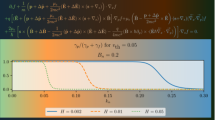“My own conclusion is that today there is no interpretation of quantum mechanics that does not have serious flaws. This view is not universally shared. Indeed, many physicists are satisfied with their own interpretation of quantum mechanics. But different physicists are satisfied with different interpretations. In my view, we ought to take seriously the possibility of finding some more satisfactory other theory, to which quantum mechanics is only a good approximation.”
Steven Weinberg.
Abstract
Schrödinger equation is a corner stone of quantum mechanics, but its simple derivation and it means its understanding is still missing. It is accepted that Schrödinger equation is based both on wave mechanics and quantum mechanics, but it does not have information about spin. Here, based on classical mechanical action and spin precession, we present elementary derivation of an analog of time-dependent Schrödinger equation in the presence of field without particle–wave duality principle. We also derive an analog of relativistic Klein–Gordon–Fock equation. The results are useful for interpretation of quantum mechanics, Pauli exclusion principle, for magnetic field-sensitive reactions, spin-related ESR spectroscopy, and ENDOR.
Similar content being viewed by others
References
Kocherginsky, N.M., Gruebele, M.: Mechanical approach to chemical transport. Proc. Natl. Acad. Sci. USA 113(40), 11116–11121 (2016)
Schrödinger, E.: Quantization as an Eigenvalue Problem, four communications. In: Ludwig, G. (ed.) Wave Mechanics, pp. 94–157. Pergamon Press, Oxford (1968)
Dirac, P.: Principles of Quantum Mechanics, 4th edn. Oxford University Press, Oxford (1982)
Fényes, I.: Eine wahrscheinlichkeitstheoretische Begriindung und Interpretation der Quantenmechanik. Z. Phys. 132, 81–106 (1952)
Nelson, E.: Derivation of the Schrödinger equation from Newtonian mechanics. Phys. Rev. 150, 1079–1085 (1966)
Nagasawa, M.: Schrödinger Equation and Diffusion Theory. Springer, Berlin (1993)
Percival, I.: Quantum State Diffusion. Cambridge University Press, Cambridge (1998)
Okino, T.: Correlation between diffusion equation and Schrödinger equation. J. Mod. Phys. 4, 612–615 (2013)
Tsekov, R.: Brownian motion and quantum mechanics. Fluct. Noise Lett 19, 2050017 (2020). (arXiv:1902.05930)
Caldeira, A.O.: An Introduction to Macroscopic Quantum Phenomena and Quantum Dissipation. Cambridge University Press, Cambridge (2014)
Schiff, L.I.: Quantum Mechanics, 3rd edn. McGraw Hill, New York (1968)
Davies, P.C.W.: The Accidental Universe. Cambridge University Press, Cambridge (1982)
Heifetz, E., Tsekov, R., Cohen, E., Nussinov, Z.: On entropy production in the Madelung fluid and the role of Bohm’s potential in classical diffusion. Found. Phys. 46, 815–824 (2016)
Yahalom, A.: The fluid dynamics of spin. Mol. Phys. 116(19–20), 2698–2708 (2018)
Byron Jr., F.W., Fuller, R.W.: Mathematics of Classical and Quantum Physics. Dover Publications Inc., New York (1992)
Feynman, R., Hibbs, A.: Quantum Mechanics and Path Integrals. Emended by Styer D. F. ed. Dover Publications, Inc., New York (2005)
Landau, L., Lifshitz, E.: Quantum Mechanics. Course of Theoretical Physics, vol. 3, 3rd edn. Butterworth Heinemann, Oxford (1997)
De Gosson, M., Hiley, B.: Inprints of the quantum world in classical mechanics. Found. Phys. 41(9), 1415–1436 (2011)
Onsager, L.: Reciprocal relations in irreversible processes. II. Phys. Rev. 38(12), 2265–2279 (1931)
Baylis, W.E., Huschilt, J., Wei, J.: Why i ? Am. J. Phys. 60(9), 788–797 (1992)
Levitt, M.: Spin Dynamics: Basics of Nuclear Magnetic Resonanse. Wiley, Chichester (2001)
Weinberg, S.: The Quantum Theory of Fields, 12th edn. Cambridge University Press, Cambridge (2016)
Thomas, L.: The motion of spinning electron. Nature 117(2945), 514 (1926)
Weinberg, S.: Lectures on Quantum Mechanics, 2nd edn. Cambridge University Press, Cambridge (2015)
Lianga, C., et al.: An undergraduate experiment of wave motion using a coupled-pendulum chain. Am. J. Phys. 83(5), 389–390 (2015)
Muralidhar, K.: Theory of stochastic Schrodinger equation in complex vector space. Found. Phys. 47, 532–552 (2017)
Bohm, D.: Quantum Theory. Dover Publications Inc, New York (1989)
Pauling, L., Wilson Jr., E.B.: Introduction to Quantum Mechanics, 3rd edn. Dover Publications Inc., New York (1985)
Gryzinski, M.: Spin-dynamic theory of the wave-corpuscular duality. Int. J. Theor. Phys. 26(10), 967–981 (1987)
Gardas, B.: Exact solution of the Schrodinger equation with the spin-boson Hamiltonian. J. Phys. A Math. Theor. 44(195301), 7 (2011)
Esposito, S.: On the role of spin in quantum mechanics. Found. Phys. Lett. 12, 165–177 (1999)
Philippidis, C., Dewdney, C., Hiley, B.: Quantum interference and the quantum potential. Nuovo Cimento B 52(1), 15–28 (1979)
Dennis, G., de Gosson, M., Hiley, B.: Bohm’s quantum potential as an internal energy. Phys. Lett. A 379(18–19), 1224–1227 (2015)
Grossmann, F., Buchholz, M., Pollak, E., Nest, M.: Spin effects and the Pauli principle in semiclassical electron dynamics. Phys. Rev. A 89(032104), 5 (2014)
Buchachenko, A.L., Lawler, R.G.: New possibilities for magnetic control of chemical and biochemical reactions. Acc. Chem. Res. 50(4), 877–884 (2017)
Buchachenko, A.L.: Stable Radicals. Consultants Bureau, New York (1965)
Berliner, L.J.: Spin Labeling: The Next Millennium (Biological Magnetic Resonance). Plenum Press, New York (1998)
Kocherginsky, N., Swartz, H.M.: Nitroxide Spin Labels. CRC Press, Boca Raton (1995)
Schweiger, A., Jeschke, G.: Principles of Pulse Electron Paramagnetic Resonance. Oxford University Press, New York (2001)
Ohanian, H.C.: What is spin? Am. J. Phys. 54(6), 500–505 (1986)
Hestenes, D.: Spin and uncertainty in the interpretation of quantum mechanics. Am. J. Phys. 47(5), 399–415 (1979)
Danner, A., et al.: Spin-rotation coupling observed in neutron interferometry. NPJ Quantum Inf. 6(23), 1–6 (2020)
Acknowledgements
The author declares no conflict of interest and wishes to thank professor M. Gruebele for interest and the School of Chemical Sciences at the University of Illinois for financial support, while this work was carried out.
Author information
Authors and Affiliations
Contributions
Not applicable, one author , who has written and submitted the manuscript.
Corresponding author
Additional information
Publisher's Note
Springer Nature remains neutral with regard to jurisdictional claims in published maps and institutional affiliations.
Rights and permissions
About this article
Cite this article
Kocherginsky, N.M. Interpretation of Schrödinger equation based on classical mechanics and spin. Quantum Stud.: Math. Found. 8, 217–227 (2021). https://doi.org/10.1007/s40509-020-00240-8
Received:
Accepted:
Published:
Issue Date:
DOI: https://doi.org/10.1007/s40509-020-00240-8




